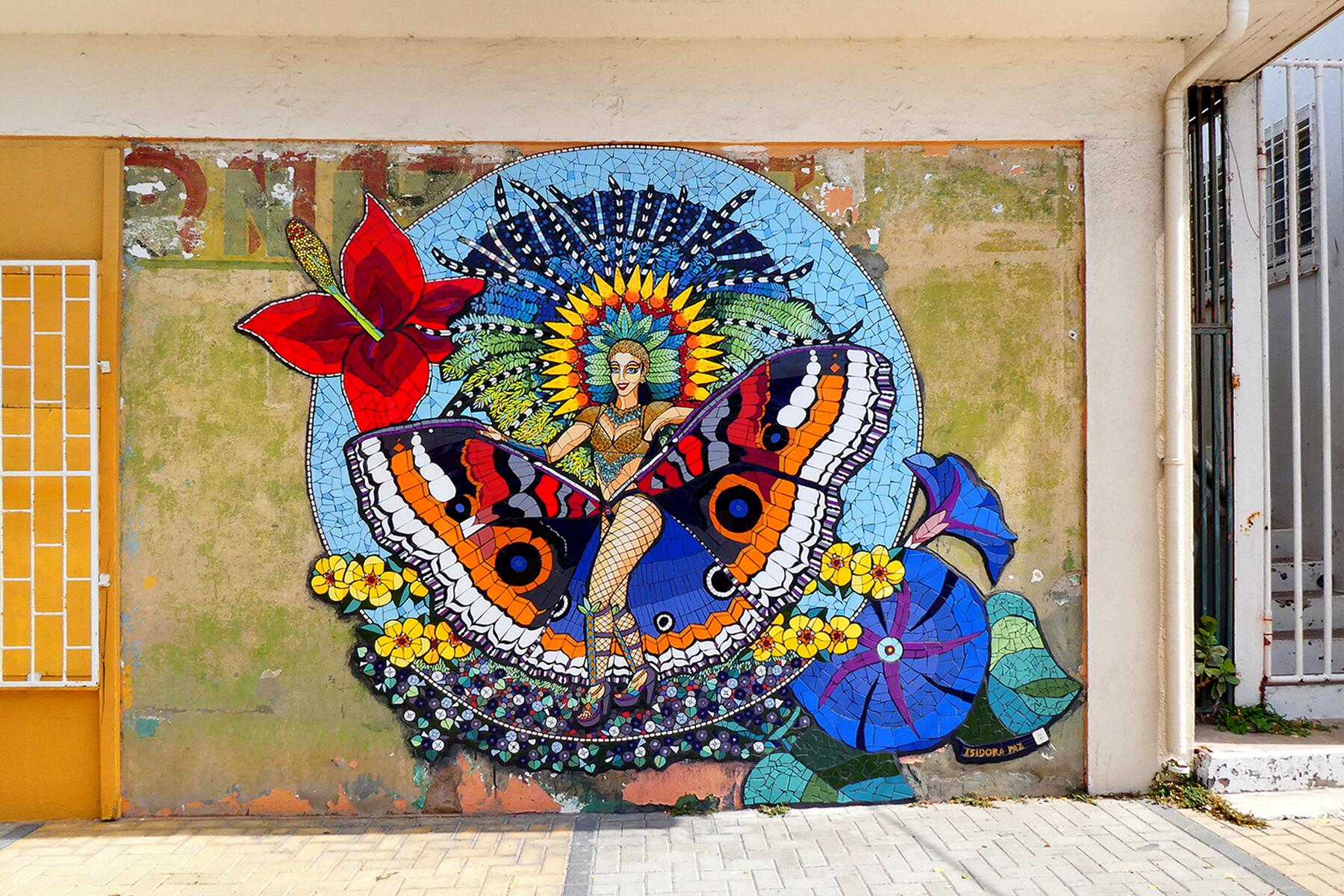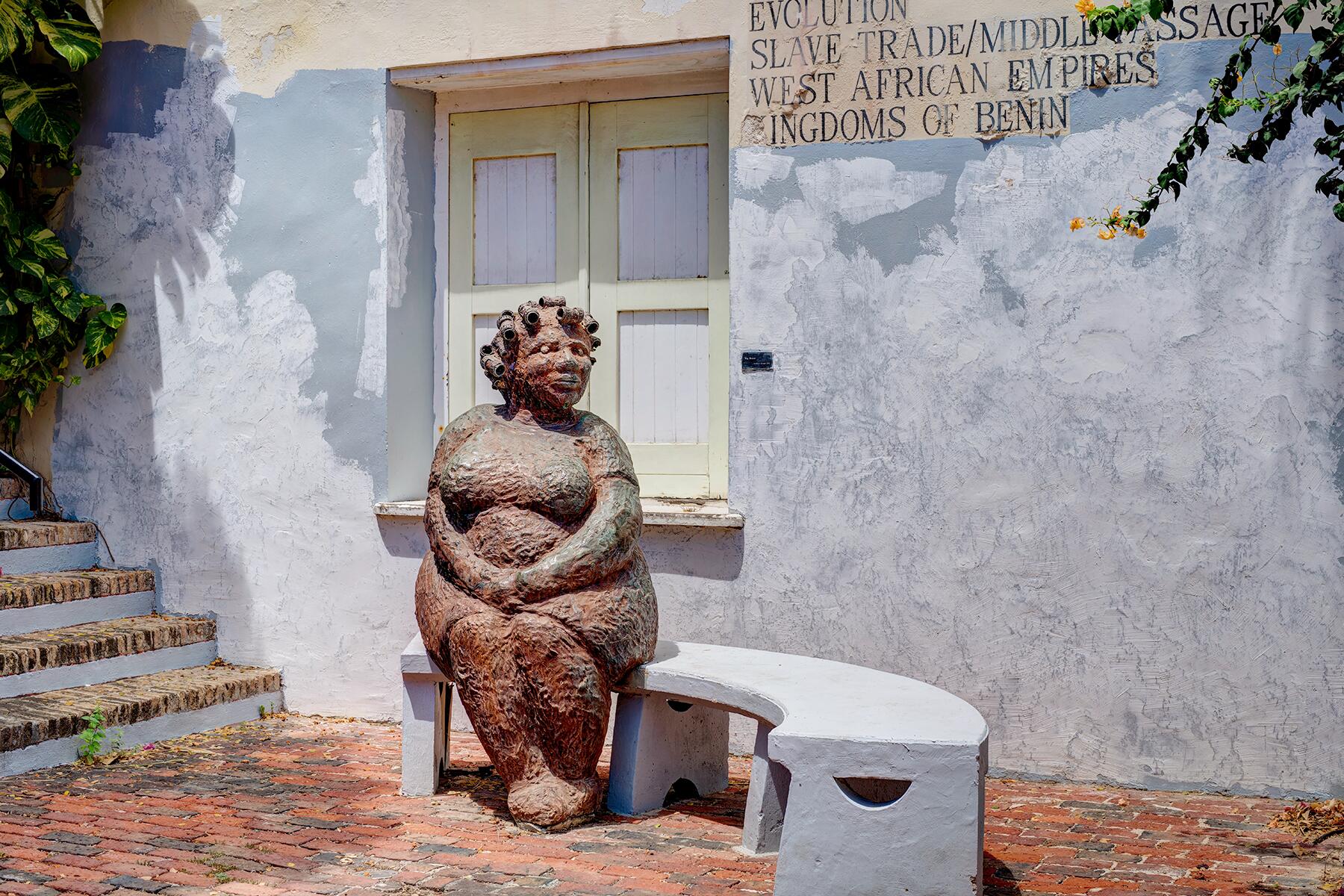Miami meets Brooklyn meets something we haven’t quite seen yet.
Ask about the world’s best art destinations, and you’re bound to get a long list of hip cities filled with bougie art galleries, crowded outdoor murals, and overpriced art fairs where tickets are impossible to snag. Of course, these places are still worthy of their credentials, but there’s no denying these art scenes now skew towards the global and unattainable rather than the local and accessible.
If you prefer your art to give you a true sense of a destination, look no further than Aruba and Curaçao: two Caribbean islands separated by a half-hour flight and known primarily, like much of the islands in the region, for their tourist-friendly resorts and azure blue waters.
But if you choose to leave your resort (and always, always leave your resort), you’ll find two art scenes that are (for the time being, at least) crowd-free, affordable. and true to the spirit of the islands.
San Nicolas, Aruba
With its hurricane-free weather, English-speaking citizens, and downright gorgeous beaches, Aruba is one of the most popular Caribbean islands for American travelers. And with 26 resort hotels and countless timeshare properties, it’s unsurprising that most visitors arrive with just two goals: sun and sand. But if you’re the type of traveler who can only do that for approximately two hours before getting bored or wary of sunburn (*raises hand*), you might wonder if a place like Aruba is really the best vacation spot for you.
Recommended Fodor’s Video

The good news is that you can find plenty of non-beach activities to fill your time, from casinos and museums to an underrated art scene. Most island activities and lodgings are focused in the capital city of Oranjestad, but the island itself is pretty small—about 70 square miles that take about two hours to drive around completely. This means there’s no excuse to limit yourself to just the capital, and the perfect excursion is the city of San Nicolas, particularly the neighborhood of Zeppenfeldstraat.
A 20-minute drive from Oranjestad on the island’s southern tip, San Nicolas was once the home to a major oil refinery (the largest employer on the island before tourism got big) and was a de-facto company town for refinery workers as well as the economic hub of the island. Once the refinery shut down, the jobs shifted to tourism and Oranjestad, leaving the city neglected.

But the last decade has seen a true revitalization, with more businesses and festivals lighting up the area, led primarily by the stunning and colorful street murals that were commissioned largely by Artisa, the part-art gallery and part-arts organization with a mission to reclaim what local Aruban art means. Started in 2017, the gallery itself features a regular rotation of local and international artists (currently all women) with gorgeous pieces that allude to cultural touchstones of the island and are unbelievably affordable. Highlights include pop-art-inspired odes to the island’s animals and giant murals created using paint rollerblades.
They also host the yearly Aruba Art Week, held every September, leading up to the three-day Aruba Art Fair and its focus on public art. In the days leading up to the art fair, you’ll see live performances, pop-up restaurants, workshops, and artist talks. Artists from all over Aruba and the world gather to showcase their work, with the highlight being the live street art that truly makes San Nicolas such a vibrant place.
Indeed, even if you aren’t in town for the art week and fair, you’ll see the leftover creations from the event nearly everywhere you turn in the city. The collection evolves yearly, adding new murals each art fair, resulting in a dazzling tour of bright colors, island motifs, and famous locals. You’ll find Instagram-worth angel wings, a mosaic Carnival dancer, a giant crab made out of recycled materials, several interactive murals, a rainbow lionfish, and giant recreations of hummingbirds, iguanas, and sea turtles. You can easily spend an afternoon exploring on your own or schedule a tour with Aruba Mural Tours (also operated by Artisa), giving you even more context and insight into individual murals and the art scene that created them.
Where to Stay: San Nicolas is still relatively undeveloped regarding lodging, so even if your trip is art-focused, it’s smart to get the best of both worlds by staying at one of Aruba’s famed resorts. Renaissance Wind Creek Aruba consists of two properties located in the heart of Oranjestad: Renaissance Aruba Ocean Suites features all suites, complete with kitchenettes and perfect for families, while just across the road is the Renaissance Aruba Resort and Casino: Marina Hotel, an adults-only hotel with spacious, elegantly designed rooms. Both feature gorgeous pools and excellent dining options, and adult guests can feel free to move around both properties as they would like. The hotel is also happy to help arrange transport to San Nicolas and to set up mural tours with Artisa.
However, the resort’s biggest perk is the access to Renaissance Island, a private oasis owned by Renaissance Hotels. A 10-minute boat ride takes guests to the island, where you’ll find the famous Flamingo Beach, named for its flock of friendly pink residents who don’t mind your photographs one bit (please just keep your distance). There’s also Iguana Beach, a full-service restaurant, a casual beach bar, and spacious cabanas available for rent. Access to the island is not only completely free for Renaissance guests but also mostly limited to hotel guests only (day passes are sometimes available for non-guests, but these are handed out pretty rarely), meaning the island never gets overcrowded.
Where to Eat: After your mural tour in San Nicolas, stop for a bite at Charlie’s Restaurant and Bar, which has been a neighborhood mainstay since 1941 and serves excellent fish, shrimp, and steaks. Back in Oranjestad, don’t miss the best steaks on the island at L.G. Smith’s Steak and Chophouse, part of Renaissance Wind Creek but open to non-hotel guests; when you see the cocktail trolley roll around, don’t miss out on ordering a drink and seeing some impressive mixology in action. You can also try Olivia, an open-air eatery specializing in creative Mediterranean cuisine with a Caribbean flair.
Otrabanda, Curaçao
Located just a short half-hour flight from Aruba, the island of Curaçao retains many characteristics of its neighbor (38 gorgeous beaches and an interesting Dutch history that has morphed into a lively hodgepodge of different cultures) while also maintaining a strong sense of identity, an impressive feat given the nearly 60 different nationalities that call this island home.
Curaçao has done an awe-inspiring job of upkeeping its historic structure, resulting in bright, candy-colored architecture that makes its capital of Willemstad, a UNESCO World Heritage city, such a delight to wander around. In fact, your first introduction to the art scene of Curaçao will likely be one of the many stalls selling various paintings and statues of the island’s most famous scene: the Handelskade, a long row of pastel-colored, 18th-century buildings along the main stretch of the city’s harbor front.

Downtown Willemstad is divided into two main neighborhoods, separated by Santa Anna Bay and connected by the iconic Queen Emma footbridge (otherwise known as the Swinging Old Lady). Punda, located east and south of the bay, is the main historic center of the island, home to several shops, restaurants, museums, and important historical sites while Otrabanda, stretching west and north, is home to the cruise terminal and Rif Fort, a developing hub for several top dining and nightlife establishments on the island. And while you can find those charming, colorful buildings in both neighborhoods, Otrabanda (which means “the other side” in Papiamentu) has taken that local color to another extreme, welcoming an impressive amount of street art that reflects the heart and soul of the island.
You could easily spend an afternoon
wandering around the narrow alleys of Otrabanda on your own, snapping photos of the seemingly endless murals and public art that grace the streets. Like with any street art, there can be a high turnover of new artists and projects at any given time, but one of the most famous is the Colorful Steps, a geometric rainbow-patterned staircase created by local artist Avantia Damberg.
The Colorful Steps, and indeed nearly all of the street art found in Otrabana, is partly due to Kaya Kaya, a yearly festival organized by locals with a deep desire to transform and revitalize the neighborhood while maintaining its culture and community. Held at the end of each summer, Kaya Kaya is a day-long party that is both a celebration of the community, with dancing, live music, food, and drinking, and a working art project, with newly commissioned artists actively creating new murals and other artists selling their wares and boosting the local economy.
Even if you’re not on the island for Kaya Kaya, a guided tour of the neighborhood will give you local insight into the murals and other public artwork and an insider view into the history and culture of the city and Curaçao at large. Art Now Tours, run by local artists Avantia Damberg (yes, of the Colorful Steps fame) and Chris Peralta, offer various street art-focused tours of Otrabanda and other neighborhoods on the island. For tours that are a little less art focused but still, give a great overview of area murals, book a private tour with local Tyrone Brunken, who is happy to share his expert knowledge of the island and the history of Kaya Kaya street art.
Where to Stay: Lodging on Curaçao tends to lean more towards guesthouses and rentals than resorts, but a stay at a major hotel like Renaissance Wind Creek Curaçao will put you in the center of the action and give you private access to a manmade infinity beach (unlike Aruba, all the beaches in Curaçao are public). Located within the historic Fort Rif (the Renaissance brand actually owns it and helps maintain its historic status while also expanding its commercial development) on Otrabanda, you’re in walking distance to all the top sights in Willemstad, along with some excellent restaurants and bars.
Where to Eat: Other Caribbean islands tend to have a strict demarcation line between tourist and local cuisine. Resort-heavy downtown caters mostly to visitors and is too expensive or too commercial to really be of any interest to the people who actually live on the island, while local haunts are too far to be accessible most travelers. Yet in Curaçao, the line between tourist and local eateries is blurred, allowing visitors to feel like they’re really getting a true sense of a place.
In no dining experience is this more evident than at Plasa Bieu, or the Old Market. This food hall-like space offers different vendors selling authentic local cuisine, from goat stew and pumpkin pancakes to red snapper and okra soup. Then for dinner, Fort Rif is abuzz with sophisticated and trendy eateries, from Ceviche 91, with its array of ceviche, to MosaCana Bar & Kitchen and its small Latin dishes with Caribbean flavors.





